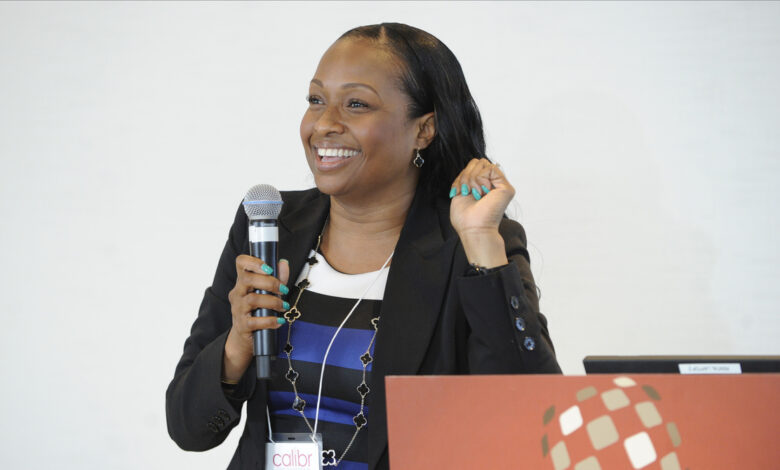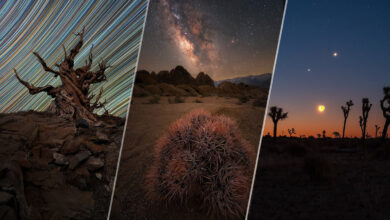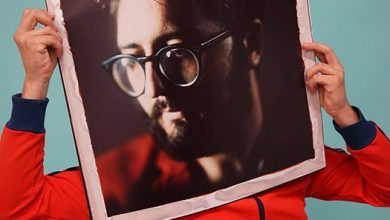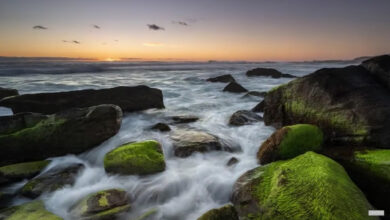Five Shots You Need to Get When You Are a Corporate Photographer

Corporate events are perhaps my favorite thing to photograph these days. There are so many different shots I can create at a conference that I am never bored. Networking opportunities are in abundance at any given corporate affair, and most of the people in the room are working for a company that has the budget to hire me to shoot for them.
Atmosphere
Photograph the scenery including details and how the room and tables are set up. As a people photographer, these are my least favorite images to create. Shooting the location is tedious, and the final images are of no interest to me. I understand their value to the client, however, so I always capture these shots. I photograph wide shots that show the entire space with all of the tables and the stage. I imagine my client needing these images a few years from now when she is setting up a room in a different city. She will tell her team: “let’s set up the room as we did in Miami a few years back.” These are the reference photos that she will use to show the team. These photos are also useful to her when she is booking a space for the next conference in a new city. She can ask a potential host “can your location accommodate a setup like this?”
I also shoot detailed shots of any items that have been given to attendees either in the form of gift bags or at the table where the attendees will be seated. Branded pens, journals, and power bricks are common. Some conferences provide tablet devices that attendees use to answer survey questions during the presentations. Someone from the client’s team has likely photographed these items on a smartphone. Whenever possible, I use my Leica M10 with a 35mm Summilux lens because it has an interesting rendering of the out-of-focus elements when used wide open. This allows my images to have a more artistic look than those captured by my client. I also photograph these shots on my Nikon with a lens set to f/5.6 just in case the artistic photos are not appropriate for the client’s final usage.
It is wise to photograph every sign at the event. Often, these signs feature the names of the sponsors and the event organizers need to be able to show that the sponsor names were prominently displayed at the event. Whenever possible, photograph these signs in the context of how they are displayed at the event by incorporating the room in which the sign was placed. It is best to take these pictures before the event begins so that you don’t have people in these shots.
There may be a sign informing attendees that they may be photographed or videotaped at this event. Your photograph proving that this sign was posted at the event could be valuable in the event of a lawsuit. There may be a sign that lists the names and appearance times of all the speakers at the event. This photograph may be useful for you if you need to caption the images or if you want to reach out to someone from the event on LinkedIn.
Grip and Grin, Step and Repeat
Take photographs of key people posing with each other and looking directly into your camera. For these images, I use the Profoto A1 flash on my Nikon Z6 or Z7. Using a 24-70mm f/4 lens, I usually shoot at f/5.6 to provide some depth of field so that all of the faces in the photograph are in focus. I will usually take one or two shots at 24mm and then quickly zoom in for a tighter composition. I take at least four photographs of every one of these shots to ensure that I have at least one image where everyone’s eyes are open.
A variation of this shot is a company group shot. Imagine you were photographing a corporate event that was focused on the topic of affordable clean energy alternatives. There may be attendees from companies such as Ford, General Motors, and Tesla, who were given the day off to attend the conference. The group photo serves as proof for these people that they attended the conference. It also allows the conference organizers to promote the fact that teams from all these various companies were present at the event. To capture these images, I inform the event organizers at some point that we need to announce to the attendees that we will be doing company photographs after lunch, at the end of the day, or whatever the case may be. If time permits, take a moment to create a more interesting composition than just having everyone stand there as they would for a phone photograph. Look over each person in the shot to make sure they have posed appropriately. Just directing each person individually will make you look like a professional photographer who cares about the final product. When people see your professional approach, they are more likely to approach you to ask for your card.
The Stage
Take pictures of everything that happens on stage. These are the core photographs that make up your coverage of the event and may be the most important photographs that you capture at the event. I photograph the presenters from a variety of focal lengths and from as many angles as I can think of. I shoot both vertical and horizontal and I leave dead space in the image where the client can put text on the image should they desire. If the stage is hosting a panel discussion with three or four speakers, I may take hundreds of images to ensure that I have shots where each person looks good. People often look awkward when photographed while speaking, so you must be sure to capture enough shots so that you have images where the person speaking looks good.
I use the Nikon Z6 and Z7 cameras interchangeably for these shots. My Z7 is set to a 26-megapixel resolution, and I can’t tell the difference between the cameras when I am shooting them, nor can I tell when I am looking at the final images. One camera has the new 24-70mm f/4 Z mount lens, and the other has a decades-old 70-200mm f/2.8 F mount lens. The newer Nikon lenses are clearly better than the older offerings, but since I use the 70-200mm focal length so infrequently, I may just continue to use this adapted lens on my Z cameras indefinitely rather than buy a newer version of this lens. My dream is to one day only accept jobs that can be photographed using focal lengths no longer than 85mm. I don’t have much interest in photographing things that are taking place 20 or 30 feet away from me.
Portraits of Presenters
Photograph clean portraits of all guests as if you had been hired to take their headshot on location. This is one of those added value shots that I provide without being asked. For this shot, I try to find a clean white background or a background that is not too distracting and I shoot a LinkedIn profile style portrait. I envision this shot being used in a newsletter recapping the event. While the client could use the photograph of the presenter speaking at the conference, I like providing a clean image as well. This image is useful in a newsletter when the presenter makes a return appearance at a future conference and the group wants to inform the members that this person will be appearing at the next event. By placing this photograph in my client’s files, I am saving them the trouble of asking the presenter for a headshot for that next appearance. And, I can’t tell you how many times the portrait that I create in my two-minute session with the presenter is a better photograph than what that person is using as their official portrait. This mini session also gives me a chance to connect with that person for a couple of minutes. This increases the chance that I will add them to my list of clients at some point.
Candids of Attendees
Photograph attendees enjoying themselves and learning at the event. These are different shots with different purposes. The photographs of the attendees participating in group activities or asking questions of the presenters are designed to show that this event is a worthwhile event for them to have attended. I envision an attendee showing this photograph to her supervisor to justify her time spent away from the office. Another photograph that I look to create is of the attendees socializing with peers and enjoying themselves at the event. I envision these images being used by the event organizers to promote the event as a good place for networking. Although these are candid images, I don’t hesitate to move people around or ask people to recreate an interaction that I may have missed. I try not to disturb people too much when I am doing these shots, so I try to read the room and approach those groups whom I feel won’t mind my disruption of their conversation to create a stronger photograph.
Be prepared to take a group photo of all the attendees and presenters at the conference. Often, the organizer of the event wants to show how many people were in attendance. If there is a staircase nearby, you may be able to use it to stagger the height of the participants so that all the faces can be seen in the final shot. It also helps if you have two flashes so that you can spread light evenly across the entire scene. There may be 75 people or more in this shot, depending on the size of the conference. A lens wider than 24mm may be necessary on occasion if you are working in a tight space.
What can you photograph that is unexpected but still of value to your client? I have done corporate gigs where I have brought studio lighting so that I could set up to take headshots on location. This isn’t something that I discussed with the client ahead of time. I bring the lighting gear, and if the location and the schedule allow for it, I suggest that we take some quick headshots. The client appreciates these images, and it opens the door for me to offer this as a paid service at a future event.
On other occasions, I used my Leica M10 Monochrom to shoot black and white candids of the group members interacting with each other. Again, this isn’t something that I suggest ahead of time since I am expecting the client to say that they don’t need black and white photographs. However, once they see how I cover the event in black and white, I am confident they will appreciate the images. The black and white camera allows me to shoot in very low-light conditions and create strong candids in lighting conditions that would not work well for a standard color camera used in its default mode as a color camera.
On a recent corporate gig, I filmed video clips in between my taking of photographs. A few months ago, my go-to video camera was the BlackMagic Pocket 4K. Filming video with this camera while I am taking pictures with a Nikon is not a smooth process since it involves walking around with two distinctly different systems. I’ve since switched to filming video on the Nikon Z6 and Z7, and these cameras excel at filming quick video clips while I am taking photographs. There is a perfectly placed thumb switch that allows me to transition between stills and video in an instant. One great thing about the design of these cameras is that you can set a different ISO, white balance, shutter speed, and aperture for video and photography. Typically, video requires a slower shutter speed and consequently lower ISO setting than still photography. I can lock in appropriate settings for each of these modes and quickly take photographs or videos that are properly exposed.
When I deliver these clips, I explain that they are intended as moving photographs rather than traditional video clips. The audio is poor, and there is very limited camera movement, but these clips are great to use in a Sportscenter-style video recap of the event. They can also be used in a slideshow alongside still the still photographs. At my most recent corporate gig, my clips from the first day of the event played in the common areas of the conference throughout the second day. On the third day of the event, clips from day two played in those areas.
I must acknowledge that there is a danger when you offer an added service that your client will come to expect this bonus offering as part of what they are entitled to. You can even find yourself in a situation where the client is looking at the bonus service you’ve provided and they are wondering why it isn’t as perfect as it would have been had that been the main job you were tasked with creating. Perhaps they are looking at the moving pictures you created and wondering why the sound isn’t good. Or they are wondering why you didn’t record the segment where the speaker said something funny, not understanding that your focus was on photographing the speaker and the video clip is just a bonus. I’ve encountered these undesirable situations, but I’ve also had many occasions where my added value offerings have resulted in additional bookings or additional payments. Consider a situation where I photographed headshots on location for the client at no additional charge, but then charged a fee for retouching each headshot image I delivered. I always aim to deliver my best, so I’m willing to take the chance that this will ultimately benefit me as much as it benefits my client and I’m confident that my bonus offerings are a way for me to stand out from my competition.
The shots described above are my standard offerings when I cover an event. If this sounds overwhelming, focus on two areas that you can photograph properly at your next shoot. After you have done that a few times, try adding in an additional shot from this list. In time, you will be able to photograph all sorts of different shots at a single event.




